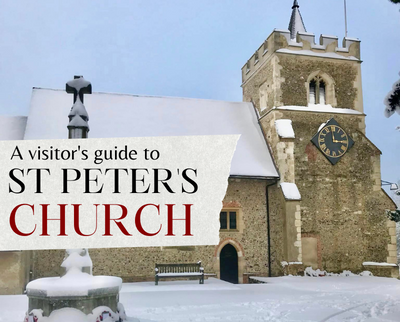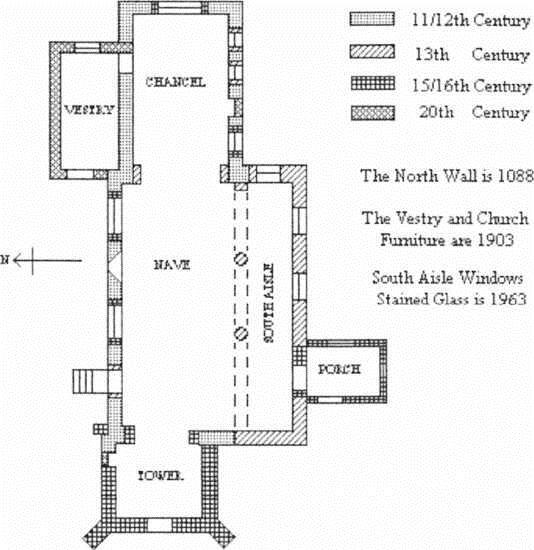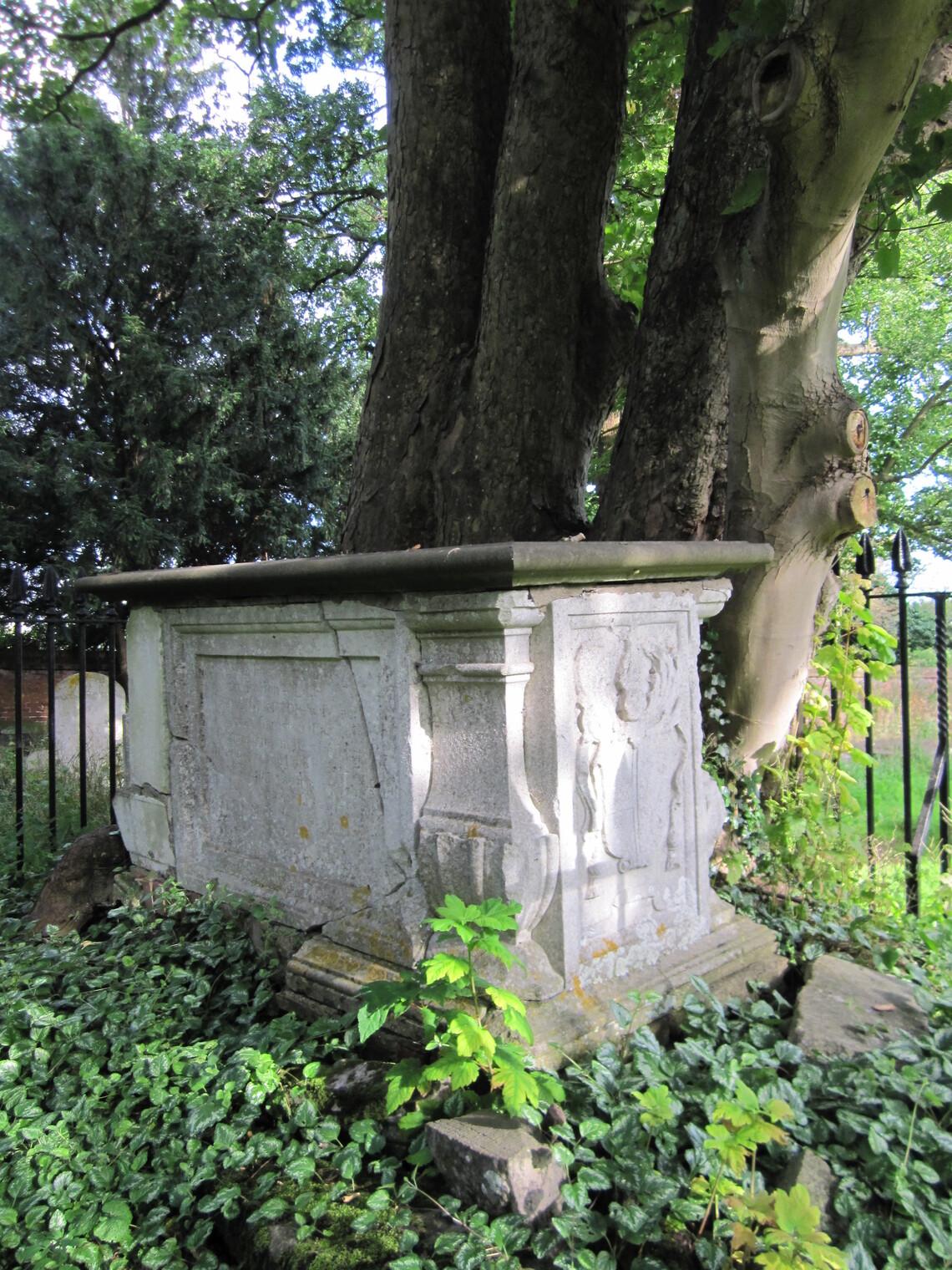
This restoration took place in or about the year of the Domesday book, 1086 AD, when the nave and chancel were built by Peter de Valoignes, Norman Sheriff of Hertford Castle. Traces of Norman windows can be seen high in the north nave wall, and Early English Clerestory windows above the pillars on the south aisle. A little round window of this period can also be seen above these pillars on the south side. The colonnade was built in the 13th century to extend the Church southwards. The niche in the second pier no doubt once contained the statue of a saint. The Chancel arch, curiously onesided, was built about the same period, In front of the Sanctuary is a stone inscribed “Orate pro anima Walteri de Louthe” (the Rector of Tewin in 1312 -1356).
In the Perpendicular period (1377 - 1547) many changes were made. The square windows, the south porch, and the tower were all added at this period. Traces of a 15th century staircase to a rood can be seen in the north wall, but there is no other trace of the Rood Screen apart from the large stones which supported it.
Few structural changes were made in the 16th and 17th centuries but there are some interesting memorials of this period. Four of the six bells in the Tower date from 1673. The Tower Clock was altered to an 8-day clock in 1741. Some of the plain glass dates from this period. There is no other old glass. Extensive restoration work was done in the Church in 1864 and more notably so in 1903, when the present oak pews, reading desk, pulpit and choir stalls were renewed by Lord Cowper. The present altar and oak panelling in the Sanctuary were given by Sir Otto Beit in 1928. The shields represent St Albans, St Peter, Jesus College, Cambridge, (Patrons of the living), and Sir Otto Beit. The centre panelling was given by Peter Briggs in 1997 in memory of his wife Mary. The Altar Cross and candlesticks were given by the Misses Egerton, of Queen Hoo. The South aisle altar was given in memory of Alfred Beit, pioneer with Cecil Rhodes in Africa. The panelling was given in memory of Lady Helm and her daughter Isabel by the family in 1997.
PLAN OF ST PETER'S SHOWING THE CHANGES THROUGH THE CENTURIES

THE MEMORIALS
In the South porch is the massive memorial brought in from its original position in the churchyard, first to the south aisle and finally to its present site. It is to the memory of the Hon. Joseph Sabine who restored and enlarged Tewin House in 1715. This house has long been demolished; all that remains is the long brick wall at the east of the Churchyard, the large cedar tree and traces of foundations in the adjacent field. He gave the land for the unique approach drive to the church, but at the same time he enclosed the main road from the village to the river so that he could enlarge his garden. It is little wonder that only his family could eulogise about him.
In the south aisle is an interesting brass of 1610 to “Thomas Pygott, Gent, whose ancestors have remayned dwelling in the towne this 300 years and upwards.” He was connected through the marriage of his daughter to the Boteler family of Hatfield Woodhall. He is the founder of one of the village charities by which poor persons still benefit to this day.
Nearby is the entrance to the vault of the Fleet family of Tewin Water, a large mansion in the Parish. A memorial to James Fleet, the Brewer of Battersea, can be seen on the south wall. A memorial to his widow can be seen above the lectern. This remarkable lady (Lady Cathcart) was said to have had a ring inscribed after her fourth marriage, “If I survive, I’ll make it five.” She died aged 97 without marrying again. Maria Edgeworth in her novel “Castle Rackrent” modelled her chief character on Lady Cathcart.
By the West door and elsewhere are memorials to the North family of Marden Hill, an ancient residence on the road to Hertford. Its history can be traced to 1050, being the property of the Abbots of St Albans until the dissolution, changing hands many times until Hugh North bought it in 1653 and developed the house.
In the Nave aisle is a memorial to Fulke Tudor, who was Rector from 1650 - 1688. He bequeathed some fine plate to the Church which is still used on Festivals. His wife’s memorial is in the Chancel.
Tablets to the Boteler family can be seen inside the church, and in the churchyard just below the East wall. Some of this renowned family lived at Queen Hoo, a small historical house which dates from 1223. The existing house was built in 1550. Sir Walter Scott finished a story by Mr Strut about Queen Hoo.
In the Sanctuary are stones to Thomas Montford, Rector until 1632, and John Montford, Rector from 1632 - 1643, when he was ejected from the living. On this latter stone is the curious inscription, “Anno restaurationis 1652,” for in this year Clergymen were allowed to return to their benefices and use the Prayer Book; in the same year John Montford was restored to his right as holder of the living, It was John Montford who first built Tewin House.
THE CHURCHYARD
The War Memorial with its design of a Crusader’s Sword and Ship is the work of Sir Herbert Baker, known for his work in Delhi and for the India House in London.
By the East wall of the Churchyard are tombstones for the Carringtons, Dennes, Feilds, and Hopkyns, all prominent figures in the life of the village, whose deeds are well recorded in parish documents. A little apart to the south are stones to the memory of John Carrington and his wife. For some time he was at Bacon’s Farm on the Hertford Road, where he wrote a diary of the day-to-day events of the district, with comments on the local inhabitants of the day. They give a detailed account of parish life during the late 18th and 19th centuries.
The Tomb in the churchyard most frequently visited by visitors from all over the world is that of Lady Anne Grimston. This is found within the iron railing at the East of the Churchyard. A legend has grown around this lady that she was a Sadducean and therefore did not believe in the Resurrection of the Dead.
She was reputed to have said, “If, indeed, there is life hereafter trees will render asunder my tomb.” For over 200 years trees have forced their limbs through the tomb to raise their branches in rejoicing. That Lady Anne was not, however, a Sadducean can clearly be seen in her notes of accounts of monies spent in putting up her horses when she drove from her home, Gorhambury, St Albans, to Tewin each Sunday for worship, calling to remembrance that it was on the First Day of the week that her Lord and Master rose from the grave. John
Steal, Curate of Tewin in 1843, deplored the superstition which had arisen around the tomb, and that “those who are led from mere curiosity and pastime be not heedless of those vows which, as professing Christians, they have solemnly made before God ‘to renounce the world, the flesh and the Devil’, being assured in their Baptism of a Life which brings ‘death unto sin and new birth unto righteousness’ ....... A sure and certain hope of the resurrection to eternal life,” May the visitor say, “Blessed are the dead which die in the Lord, for they rest from their labours.”
LADY ANNE GRIMSTON'S GRAVE
CONCLUSION
The visitor may have travelled many miles to reach this place. Whilst he gazes at all around him his mind will travel still further through long passages of time. Surely he cannot but help wonder at the Faith of those who established Christian worship here in the 7th century and their successors who, in the same Faith, have lived through to this age to give Glory to God in this His House. No other place in our community is so unique in that it has continuously been used to the same purpose for such a span of time. For many centuries people of this place have come each for the same purpose and have fallen to their knees in wonder, adoration, and praise. For 1300 years the same faith has been preached and accepted in this place. Today, just as then, this place and its people bear witness that Jesus Christ is “the same yesterday and today and for ever.” He was, is, and ever will be Lord and Master of us all.
Friend, Go forth into the world in peace: be of good courage; hold fast that which is good; render to no man evil; strengthen the fainthearted; support the weak; help the afflicted; honour all men; love and serve the Lord, now and always. Amen.


